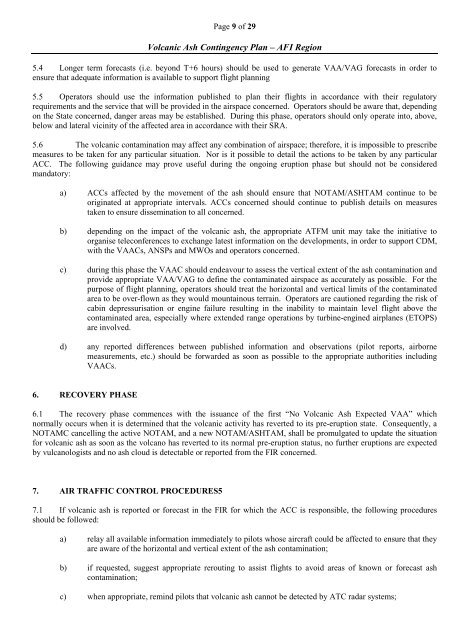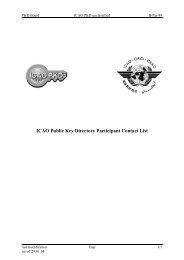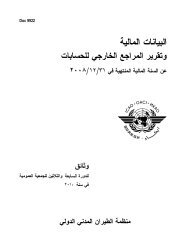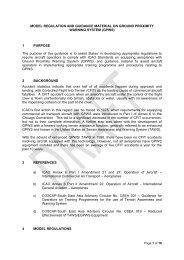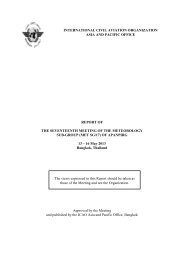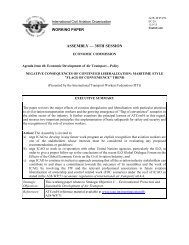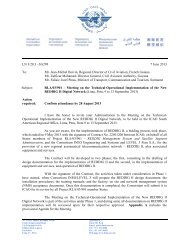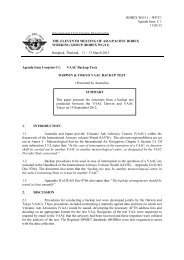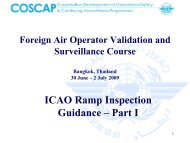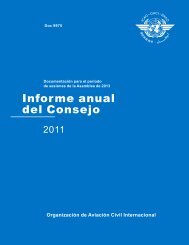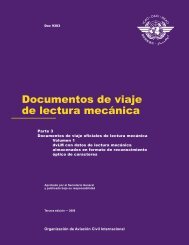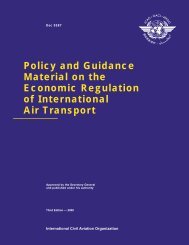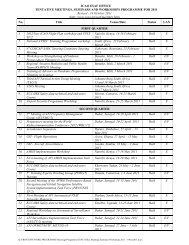afi met bulletins exchange (ambex) handbook - ICAO
afi met bulletins exchange (ambex) handbook - ICAO
afi met bulletins exchange (ambex) handbook - ICAO
You also want an ePaper? Increase the reach of your titles
YUMPU automatically turns print PDFs into web optimized ePapers that Google loves.
Page 9 of 29<br />
Volcanic Ash Contingency Plan – AFI Region<br />
5.4 Longer term forecasts (i.e. beyond T+6 hours) should be used to generate VAA/VAG forecasts in order to<br />
ensure that adequate information is available to support flight planning<br />
5.5 Operators should use the information published to plan their flights in accordance with their regulatory<br />
requirements and the service that will be provided in the airspace concerned. Operators should be aware that, depending<br />
on the State concerned, danger areas may be established. During this phase, operators should only operate into, above,<br />
below and lateral vicinity of the affected area in accordance with their SRA.<br />
5.6 The volcanic contamination may affect any combination of airspace; therefore, it is impossible to prescribe<br />
measures to be taken for any particular situation. Nor is it possible to detail the actions to be taken by any particular<br />
ACC. The following guidance may prove useful during the ongoing eruption phase but should not be considered<br />
mandatory:<br />
a) ACCs affected by the movement of the ash should ensure that NOTAM/ASHTAM continue to be<br />
originated at appropriate intervals. ACCs concerned should continue to publish details on measures<br />
taken to ensure dissemination to all concerned.<br />
b) depending on the impact of the volcanic ash, the appropriate ATFM unit may take the initiative to<br />
organise teleconferences to <strong>exchange</strong> latest information on the developments, in order to support CDM,<br />
with the VAACs, ANSPs and MWOs and operators concerned.<br />
c) during this phase the VAAC should endeavour to assess the vertical extent of the ash contamination and<br />
provide appropriate VAA/VAG to define the contaminated airspace as accurately as possible. For the<br />
purpose of flight planning, operators should treat the horizontal and vertical limits of the contaminated<br />
area to be over-flown as they would mountainous terrain. Operators are cautioned regarding the risk of<br />
cabin depressurisation or engine failure resulting in the inability to maintain level flight above the<br />
contaminated area, especially where extended range operations by turbine-engined airplanes (ETOPS)<br />
are involved.<br />
d) any reported differences between published information and observations (pilot reports, airborne<br />
measurements, etc.) should be forwarded as soon as possible to the appropriate authorities including<br />
VAACs.<br />
6. RECOVERY PHASE<br />
6.1 The recovery phase commences with the issuance of the first “No Volcanic Ash Expected VAA” which<br />
normally occurs when it is determined that the volcanic activity has reverted to its pre-eruption state. Consequently, a<br />
NOTAMC cancelling the active NOTAM, and a new NOTAM/ASHTAM, shall be promulgated to update the situation<br />
for volcanic ash as soon as the volcano has reverted to its normal pre-eruption status, no further eruptions are expected<br />
by vulcanologists and no ash cloud is detectable or reported from the FIR concerned.<br />
7. AIR TRAFFIC CONTROL PROCEDURES5<br />
7.1 If volcanic ash is reported or forecast in the FIR for which the ACC is responsible, the following procedures<br />
should be followed:<br />
a) relay all available information immediately to pilots whose aircraft could be affected to ensure that they<br />
are aware of the horizontal and vertical extent of the ash contamination;<br />
b) if requested, suggest appropriate rerouting to assist flights to avoid areas of known or forecast ash<br />
contamination;<br />
c) when appropriate, remind pilots that volcanic ash cannot be detected by ATC radar systems;


